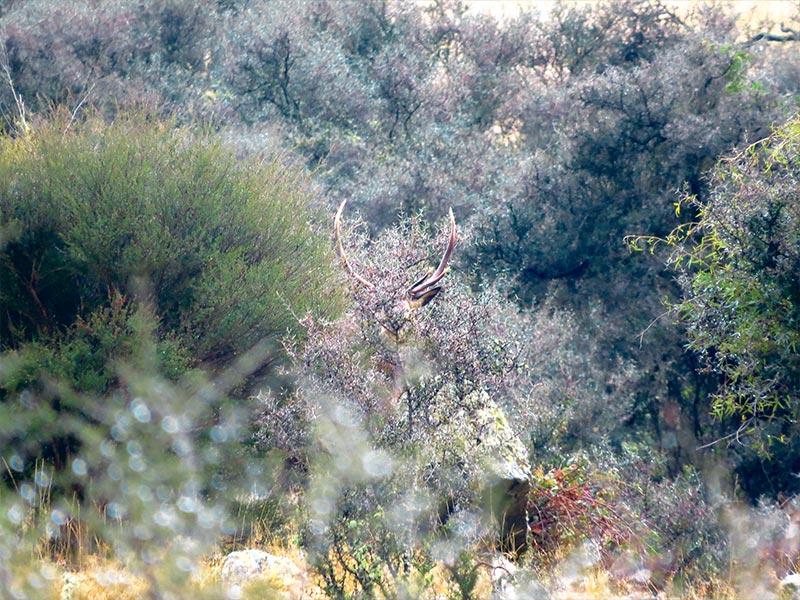Know your target: avoiding fatal mistakes
4 min read
A pair of antlers in the scrub. Is it a hunter carrying antlers or a deer? In this case, it is a stag. Photo: Tony Orman
Let me tell you about a good friend – the late Bill Axbey, who grew up as a youngster learning to hunt, went deer culling, and continued to recreationally hunt in his working career as a conservator for the Fiordland National Park.
Bill came near to being shot by another hunter in the Billy Burn, which runs down eastwards from the Franklin Mountain’s tussock tops to flow into Lake Te Anau. He was carrying two hind legs of venison on his shoulders when from behind him, a shot rang out and a bullet sped past his left ear.
The bullet went through one of the hind legs Bill was carrying, passing just above his left shoulder, luckily missing his arm, and passing his left ear just three inches or so away.
“It just flattened me, knocked me down completely, and I had a stiff neck for a couple of weeks afterwards,” Bill told me with a laugh.
But it was no laughing matter that day in the Billy Burn. Bill was shocked and angered and struggled to his feet to confront the hunter.
Perhaps Bill was at fault for carrying the hindquarters over his shoulder? But then the shooter failed to positively identify his target. Should Bill have had a brightly coloured cloth over the hindquarters?
Bill and the wayward shooter were not hunting together, but that is a minor aspect, for surprisingly, research has shown that in most of the incidents, the shooter and victim are in the same hunting party and have separated to hunt independently.
NZ Police inspector Joe Green has carried out an analysis of 33 hunting accidents between 1979 and 2002. In 64% of cases, the deceased and the shooter were in the same hunting party, and in just 18%, they were not. In the remaining 28%, it was unknown if the shooter and the deceased were in the same party.
In most cases, the shooter knew the deceased to be in the same general area.
Typical of such cases was that of two hunters who were well-known to each other and had hunted together on many previous occasions. On the evening before the accident, the party members had discussed the next day’s hunt and worked out their individual hunting areas, intending not to stray into each other’s patch. On the morning of the accident, the victim left the hut and headed towards his hunting area wearing camouflage clothing and a backpack.
The other hunter left the hut later that morning, travelling in a different direction. After deerstalking for some time, he saw what he thought were two deer in the bush nearby. He took a few moments to identify the animals. This is where it gets puzzling. He identified what he thought were deer by looking with the naked eye, looking through a rifle scope, using the rifle scope at different magnifications, and moving from left to right to gain different perspectives.
He saw what he believed to be a deer, based on shape including seeing antlers, colour, and animal behaviour. He believed he saw one of the deer walk away and took a shot at a distance later measured at just 20.3 metres from his target. Walking forward to recover the deer, he discovered he had shot his companion.
Working out their respective hunting areas and keeping to their own hunting areas was a method that the two hunters had used many times before. But the victim had strayed from his pre-determined hunting area into his partner’s area. Perhaps, if he had not strayed, the accident would not have happened. Nor would an accident have happened if the friend had thoroughly identified his target.
That aberration has been well-known for years. A research study in the US many years ago told of it. In the study, the participants were presented with three-quarters of a second flash pictures of men and deer in the field. The participants had to identify the pictures as man or deer or leave the answer to the test sheet blank. Guessing was discouraged by a three-point penalty while there was only a one-point penalty for a blank answer.
The purpose was to prove to hunters that it took some time to make the necessary positive identification of deer in the bush. The impact on hunters was marked. The study concluded the two basic causes of hunting accidents were:
- an untrained bushman’s eye because of inexperience
- a psychological-emotional state that blocked out or hindered normal visual perception
As many admitted, there was “a funny feeling in my stomach when I identified a man as a deer.”
That psychological twist is underrated. Many years ago, as editor of the New Zealand Deerstalker’s magazine, I interviewed a chap who had shot his hunting companion. Roger was adamant that he did see a deer at which he fired but turned out to be his hunting friend. On the other hand, Roger knows the reality was he shot his best mate.
But he was insistent I publish his story because he hoped it would prevent other hunter misidentifications and deaths from happening.



